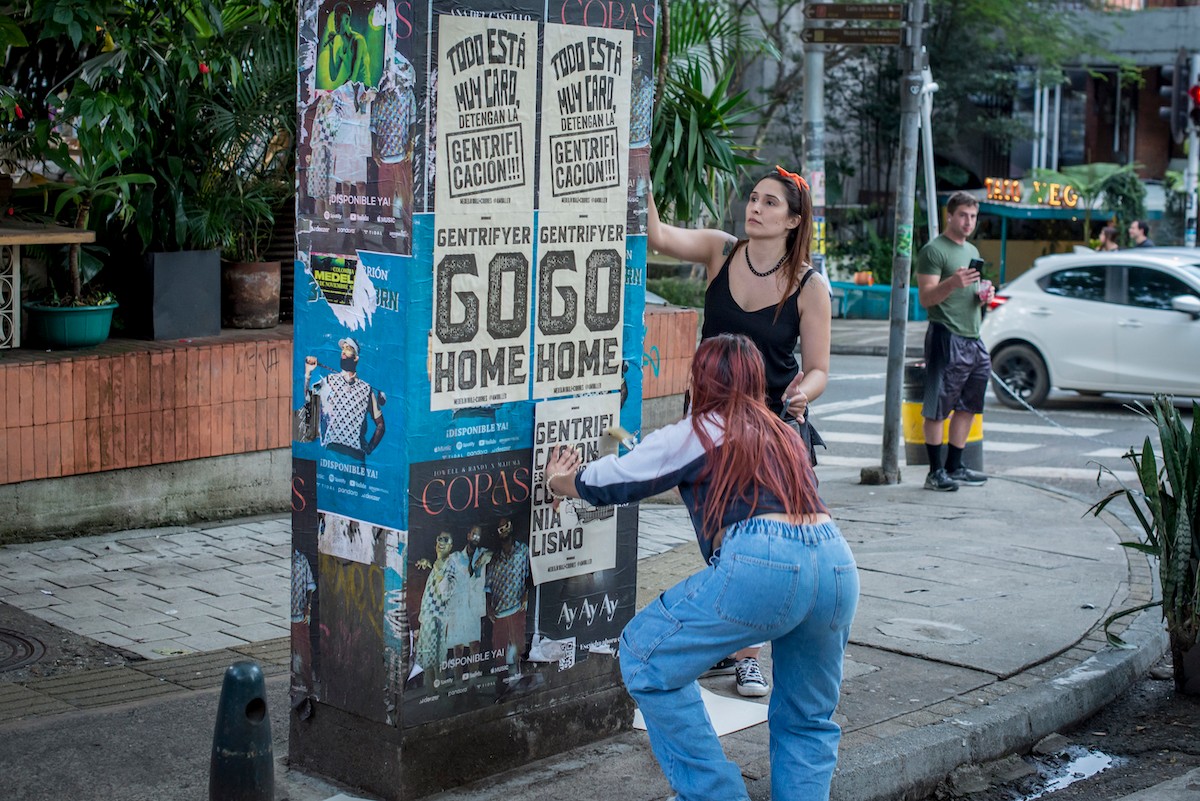The posters took over almost every wall in the party barrio of Provenza in Medellín, Colombia: “I’ll trade an Airbnb for a neighbor and a home.” “Medellín is not for sale — stop gentrification.” “Digital nomads, temporary colonizers.”
The flyposting was the work of Ana Maria Valle Villegas, a local who lives in one of the areas of the city most affected by a mass influx of digital nomads. She spent a Friday afternoon in April plastering them across the neighborhood, starting a conversation that spread from begrudging local expats in the Medellin Expats Facebook group moaning about the public support the posters received, to Medellín Twitter and even the opinion pages of local newspapers.
“I live in a zone where rents have been going up, and we’ve seen renters asked to move out because landlords want to turn their properties into Airbnbs or let them to foreigners for an inflated value,” she tells VICE. “Friends, family and myself, we’ve all experienced it.”

Ana Maria Valle Villegas (top) and a friend flyering in Medellin, Colombia. Photo courtesy of Ana Maria Valle Villegas
Let’s play a game of “spot the digital nomad” – it’s not a hard one. Think backpacker but remove the struggle, replace the mammoth rucksack with a tote bag filled with an obscene amount of Apple products that they’ll arrange in a flatlay for their IG story before calling it a day, just in time for happy hour. Rinse, repeat. One final clue? 76 percent of them are white.
Before the pandemic, the phrase “digital nomad” was only spotted on niche Facebook groups and forums dedicated to remote workers who saw themselves as pioneers of a new way of life. Thanks to the rise of remote work, though, the idea of working in different parts of the world for anywhere from a month to a few years has gained increasing currency.
According to Think Remote, a media outlet dedicated to the WFH lifestyle, the number of people who identified as digital nomads nearly tripled between 2019 and 2022, jumping from 10.9 million pre-pandemic to 35 million in three years.
And who can blame workers for jumping on to the trend? If you’ve got to sell your soul to the capitalist grind, doing it abroad has to be the best way to go about it. That appeal grows tenfold when you get to do it from somewhere sunny that is perceived as cheap and beautiful — like many Latin American and Southeast Asian cities are.
“I work and I feel like my vacation starts as soon as I clock out,” says Austin Abeyta, a 32-year-old digital nomad currently in the Philippines. “I do agree areas frequented by digital nomads go up in price – but we’re paying X amount to live in El Poblado, compared to what a Colombian would pay to live next door. You’re driving up prices, but mostly for other digital nomads.”
If the public support of Villegas’s posters is any indication, the rent hikes have been felt by everyone across Medellín. And it’s not just higher prices that locals are suffering from — the entire social fabric of the city is changing.
Las tiendas de barrio – corner shops, typically long-running mainstays in a local area – “have been disappearing,” says Valle Villegas, “because it becomes more profitable to have businesses like cafes or co-working spaces”. In neighborhoods popular with digital nomads, “all you can see are foreigners. It’s evidenced in something so simple, which… [is] that menus at restaurants are now in Spanish and in English. Six months ago, that didn’t happen.”
That’s just the tip of the iceberg. Following crime complaints by overseas visitors, the local government in Medellín decided to close off Plaza Botero in early February. The emblematic plaza in the centre of the city, home to sculptures by leading Colombian artist Fernando Botero, is now surrounded by fences, police officers and control points. “You’d think it’s the Vatican,” Valle points out.
The move was heavily criticized by locals as a way to placate foreigners to the detriment of the city. Even the 91-year-old Botero took it upon himself to write a letter to Daniel Quintero, the mayor of Medellín, asking him to open up the space for all.
But it didn’t fix the issue. Instead it meant that crime that once took place inside the plaza – including drug dealing and solicitation – has begun spreading out to nearby areas of the city. To make matters worse, Quintero recently announced that he was considering similar measures for other popular zones in the city.
In Mexico City, locals are also complaining of sky-high rents, especially in the areas frequented by gringos – the Latin term once synonymous with Americans, but now commonly used to describe any white foreigners (see: the ones in flip-flops who like wearing sombreros and think it’s cute to say they “no speako español”).
In late 2022, the Mexican government announced a deal with Unesco and Airbnb to promote the city as a “global hub” for remote workers. “This is a way for the government to raise funds,” explains Gonzalo Vazquez de Icaza, a lawyer and content creator born and raised in the Mexican capital. “Money is coming into the country and it helps governments, especially local governments, so there is an economic benefit. But there’s certain zones in Mexico City where you can see a rental crisis, where people who had been renting for years have been pushed out by their landlords because renting their property out to a foreigner is more lucrative.”
Rents in Mexico City have jumped around 30 percent over the last three years, but in digital nomad hotspots like La Condesa, they’ve increased by over 60 percent. But the effect goes beyond rental prices or how much it costs to get a cup of coffee. The city sounds different.
“It’s shocking,” Vazquez de Icaza says. “I was out for dinner with my girlfriend in one of these zones, and you hear more English than Spanish. It’s so clear when you go out on a Friday night, there’s foreigners everywhere. I don’t see it as a bad thing – I’m glad these people chose to come here. But I’m very aware of the problems that it brings, in terms of gentrification and the people that are being displaced by it.”
The rise in overseas workers – and the creation of specific visas by Mexican and Colombian governments to accommodate them – means that it’s pretty much inevitable that rent goes up. Digital nomads, who typically get paid in currencies like the euro or US dollar and earn an average yearly salary of $120,000, will be the ones who can afford it. It’s locals who lose out.
“The digital nomad, regardless of what it is that they’re doing, falls into the category of a higher income person,” says Dr Henry Louis Taylor, professor at the Department of Urban and Regional Planning at the University of Buffalo.
Their presence will “wittingly or unwittingly reinforce or intensify the processes of gentrification that may be occurring”,” he adds.
This is acutely felt in Puerto Rico. The island has suffered from gentrification for years, especially following the approval of tax exemptions for non-Puerto Ricans in 2012. The arrival of digital nomads has only made things shittier, locals say.
“My mum lives in the tourist area of Condado in San Juan, and I was seeing all of these tourists that I wouldn’t see before,” explains Federico de Jesús, co-founder of media project Losing Puerto Rico, which highlights the crises faced by the island due to legislation such as Act 22, which exempts typically rich non-Puerto Ricans from paying tax on passive income as long as they live on the island for half the year.
When De Jesús travelled back to Puerto Rico after Hurricane Maria, he says he didn’t recognize his hometown. “In my social life, when I went to Viejo San Juan,” he says of the historic district in the island’s capital, “[and] my friends would bring this ‘John Smith’ who’s here with Act 22 – they were nice, sure, nothing wrong with that.
“But I saw so many foreigners, and so many foreigners that weren’t respecting Puerto Rico, jumping on cars, shouting at people, leaving without paying, making comments about how we should speak English because Puerto Rico is a US territory… When I looked into it, into all the houses they were buying up, I realized it was a Puerto Rico that I didn’t know.”
The digital nomad effect is especially obvious in the seaside town of Rincón to the north, which is now known colloquially as Grincón (a portmanteau of gringo and Rincón). Rincón has been frequented by gringos for decades because of its reputation as a surfing hotspot, but digital nomads have only exacerbated the town’s gringo-fication.
In a TikTok filmed in Rincón by Edison Lopez, a Puerto Rican born and raised in Florida who frequently travels home, he films the streets of Rincón, overflowing with gringos drinking on the street and dancing to drum and bass and techno. “I feel like I’m in Fort Lauderdale,” he says in the video, looking equal parts disgusted and shellshocked.
“When you go to Rincón it’s a huge culture shock,” Lopez tells VICE. “Puerto Rico is very Americanized compared to the rest of Latin America because it is a US territory, but that town specifically you’re just gonna see a bunch of gringos.You’re going to hear mostly English. My friends and I tried to go partying that night and there were just a bunch of gringos playing American music, which was really weird. We felt uncomfortable in our own island.”
Jesenia Lee Irájamatunaí Valdez, a 28-year-old Puerto Rican living in the coastal city of Ponce, says her home is still relatively safe, but she’s worried this won’t last for long. “Even though gringos come for a Puerto Rican experience, they have their own tastes,” she explains. “And it changes our cultural aspects, from our diets to our language, because now we have to cater to them.”
“Two months ago I went to San Juan, and it was the biggest culture shock I got. Every corner I turn, every three seconds, there’s a gringo. And I’m like, where’s my people at?”
So is there an ethical way to be a digital nomad? “A nomad isn’t the problem,” Dr Taylor argues. “The problem is neoliberal capitalism and the way it operates. You have to have policies that safeguard the interests of ordinary people and state officials have to understand what the impacts will be in their local areas, and then mitigate those impacts by utilising all the new resources that come in through all the activities of the digital nomad; to use those resources in ways that can have a positive impact.”
Not all digital nomads are clueless about their impact. Julia Massegos, 27, has been living and working in Portugal, Italy, the Balkans and Indonesia among others for the last four years. As well as documenting her life as a digital nomad, she has set up a course for hopefuls who want to follow in her footsteps. Right now she’s in Argentina, where her partner is from, with his family. She thinks about the ethics of her lifestyle a lot, especially after someone called her a neocolonialist on a TikTok promoting her course, accusing her of “recruiting other neocolonialists”.
“All I can do is live in a way that’s going to allow me to look in the mirror every day,” Massegos tells VICE. For her, that involves shopping local, learning the language and being respectful of customs and traditions.
Maybe making your presence as a foreigner as inoffensive as possible is as easy as that— but until governments prioritize locals ahead of foreign capital, all Puerto Ricans like de Jesús can do is watch while gringos keep dancing offbeat to Bad Bunny and continue to disfigure the cities locals are struggling to recognize.



